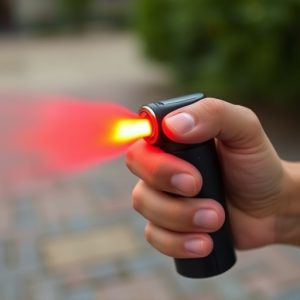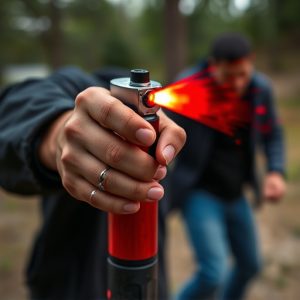Gel vs Traditional Pepper Spray: Law Enforcement’s Riot Control Choices
In the context of riot control, gel-based oleoresin capsicum (OC) spray offers distinct advantages o…….
In the context of riot control, gel-based oleoresin capsicum (OC) spray offers distinct advantages over traditional pepper spray in targeted application and prolonged irritation, especially in confined spaces or against masked rioters. While gels enhance officer safety and crowd management, traditional pepper spray, more commonly regulated, emphasizes minimal use of force and proportionality. The global legal landscape for riot control agents balances public safety and civil liberties, sparking debates about the effectiveness and potential overreach of gel-based sprays.
Riot control agents play a significant role in law enforcement, but understanding their nuances is crucial. This comprehensive guide explores the world of riot control substances, focusing on a key distinction: gel versus traditional pepper spray. We delve into the differences, implications for police tactics, and the legal framework surrounding their use. By comparing these two agents, we aim to equip officers with insights to navigate challenging situations effectively while adhering to legal boundaries.
- Understanding Riot Control Agents: A Comprehensive Overview
- Gel vs Traditional Pepper Spray: Key Differences and Implications for Law Enforcement
- The Legal Framework Surrounding Riot Control Agent Use in Law Enforcement
Understanding Riot Control Agents: A Comprehensive Overview
Riot control agents, often referred to as less-lethal weapons, are chemical compounds designed to disrupt and disperse crowds while minimizing harm to both civilians and law enforcement officers. These agents work by causing irritation or disorientation, enabling easier crowd control during demonstrations, protests, or civil unrest. Understanding the dynamics of these substances is crucial for effective deployment and safety measures.
One notable distinction among riot control agents is the debate between gel-based formulas and traditional pepper spray. Gel formulations, such as oleoresin capsicum (OC) gel, offer a more targeted application, often in the form of a sticky residue that adheres to skin and clothing. This can be advantageous in confined spaces or when dealing with aggressive rioters. In contrast, traditional pepper spray disperses in an aerosol form, creating a cloud of irritants. The choice between these two depends on various factors, including tactical needs, environmental conditions, and the specific challenges posed by the riot scenario.
Gel vs Traditional Pepper Spray: Key Differences and Implications for Law Enforcement
In the realm of riot control and law enforcement, the choice between gel-based and traditional pepper spray can significantly impact effectiveness and officer safety. Gel pepper spray, a relatively newer option, offers distinct advantages over its aerosol counterpart. One key difference lies in application and coverage; gel formulations adhere to targets, ensuring more prolonged and targeted irritation, even in windy conditions. This feature proves particularly useful in close-quarters combat or when dealing with masks or face shields commonly used by protesters.
Implications for law enforcement agencies are profound. Gel spray can enhance the control of agitated crowds, providing officers with a more precise tool to de-escalate situations without resorting to physical force. Additionally, gel’s non-aerosol nature reduces risks associated with aerosol sprays, such as cross-contamination and off-target effects. These differences underscore the potential for gel pepper spray to revolutionize riot control tactics, offering both enhanced effectiveness and improved safety for law enforcement officers.
The Legal Framework Surrounding Riot Control Agent Use in Law Enforcement
The legal framework governing the use of riot control agents by law enforcement varies across jurisdictions, reflecting a delicate balance between maintaining public safety and respecting civil liberties. In many countries, the deployment of such agents is strictly regulated to ensure their responsible use. This regulation often outlines specific circumstances under which these substances can be employed, including crowd control during demonstrations or civil unrest. The focus is on minimizing harm to both officers and civilians while addressing urgent security concerns.
One key distinction in these regulations pertains to the use of gel-based versus traditional pepper spray. Gel riot control agents, known for their longer-lasting effects and ability to penetrate protective gear, have sparked debates about their potential overreach. In contrast, traditional pepper spray has been more commonly used and regulated, with guidelines emphasizing proportionality and the minimal use of force. This comparison highlights the ongoing discussions surrounding the legal limits and effectiveness of these riot control measures, especially in light of evolving tactics and concerns about public safety during large-scale events.
In examining the role of riot control agents in law enforcement, particularly highlighting the distinction between gel and traditional pepper spray, it’s evident that each presents unique advantages and challenges. As agencies navigate the legal framework surrounding their use, understanding these differences is crucial for effective and responsible crowd control. The evolving landscape demands a balanced approach, ensuring public safety while respecting civil liberties. Ultimately, staying informed about innovations like Gel Vs Traditional Pepper Spray allows law enforcement to make data-driven decisions, enhancing their ability to maintain order without undue harm.


